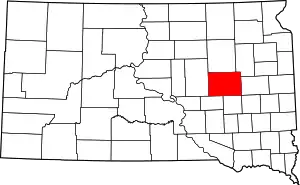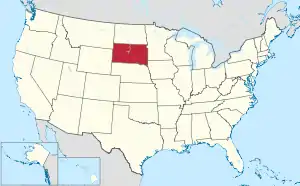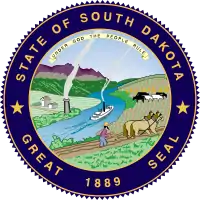Beadle County, South Dakota
Beadle County is a county in the U.S. state of South Dakota. As of the 2010 United States Census, the population was 17,398.[1] Its county seat is Huron.[2] The county was created in 1879 and organized in 1880.[3] Beadle County comprises the Huron, SD Micropolitan Statistical Area.
Beadle County | |
|---|---|
 | |
 Location within the U.S. state of South Dakota | |
 South Dakota's location within the U.S. | |
| Coordinates: 44°25′N 98°17′W | |
| Country | |
| State | |
| Founded | 1879 (created) 1880 (organized) |
| Named for | William Henry Harrison Beadle |
| Seat | Huron |
| Largest city | Huron |
| Area | |
| • Total | 1,265 sq mi (3,280 km2) |
| • Land | 1,259 sq mi (3,260 km2) |
| • Water | 6.1 sq mi (16 km2) 0.5% |
| Population (2010) | |
| • Total | 17,398 |
| • Estimate (2018) | 18,883 |
| • Density | 14/sq mi (5.3/km2) |
| Time zone | UTC−6 (Central) |
| • Summer (DST) | UTC−5 (CDT) |
| Congressional district | At-large |
| Website | beadle |
History
Beadle County, named for Brigadier General William Henry Harrison Beadle,[4] was created by the Dakota Territory Legislature in 1879, and was organized in 1880 with the appointment of three county commissioners by Governor Nehemiah G. Ordway. The first town within Beadle County was Cavour, but Huron was named the county seat when the county commissioners first met there in July 1880.
Geography
The James River flows south-southeastward through the eastern central part of Beadle County.[5] The terrain of Beadle County consists of low rolling hills, sloping toward the river valley. The county's highest point is its SW corner, at 1,841' (561m) ASL. Its lowest point is on the south boundary line, where James River flows into adjacent Sanborn County, at 1,230' (375m) ASL.[6]
The county has a total area of 1,265 square miles (3,280 km2), of which 1,259 square miles (3,260 km2) is land and 6.1 square miles (16 km2) (0.5%) is water.[7]
Major highways
 U.S. Highway 14
U.S. Highway 14 U.S. Highway 281
U.S. Highway 281 South Dakota Highway 28
South Dakota Highway 28 South Dakota Highway 37
South Dakota Highway 37
Adjacent counties
- Spink County - north
- Clark County - northeast
- Kingsbury County - east
- Sanborn County - southeast
- Jerauld County - southwest
- Hand County - west
Protected areas
- Bob Roe Memorial State Game Production Area
- Brecken Slough State Game Production Area
- Cavour Lake State Game Production Area
- James River School State game Production Area
- Lake Byron Hogsback State Game Production Area
- Mallard Slough State Game Production Area
- Mud Lake State Game Production Area
- North Byron State Game Production Area
- Norwegian/Borden State Game Production Area
- Pheasant Country State Game Production Area
- Sand Creek State Game Production Area
- South Byron State Game Production Area
- South James River State Game Production Area
- Staum Dam State Game Production Area
- Third Street Dam State Game Production Area
- Upper Cain Creek State Game Production Area
Demographics
| Historical population | |||
|---|---|---|---|
| Census | Pop. | %± | |
| 1880 | 1,290 | — | |
| 1890 | 9,586 | 643.1% | |
| 1900 | 8,081 | −15.7% | |
| 1910 | 15,776 | 95.2% | |
| 1920 | 19,273 | 22.2% | |
| 1930 | 22,917 | 18.9% | |
| 1940 | 19,648 | −14.3% | |
| 1950 | 21,082 | 7.3% | |
| 1960 | 21,682 | 2.8% | |
| 1970 | 20,877 | −3.7% | |
| 1980 | 19,195 | −8.1% | |
| 1990 | 18,253 | −4.9% | |
| 2000 | 17,023 | −6.7% | |
| 2010 | 17,398 | 2.2% | |
| 2019 (est.) | 18,453 | [8] | 6.1% |
| US Decennial Census[9] 1790-1960[10] 1900-1990[11] 1990-2000[12] 2010-2018[1] | |||
2000 census
As of the 2000 United States Census,[13] there were 17,023 people, 7,210 households, and 4,535 families in the county. The population density was 14 people per square mile (5/km2). There were 8,206 housing units at an average density of 6 per square mile (3/km2). The racial makeup of the county was 96.93% White, 0.69% Black or African American, 0.95% Native American, 0.31% Asian, 0.02% Pacific Islander, 0.26% from other races, and 0.85% from two or more races. 0.91% of the population were Hispanic or Latino of any race. 49.9% were of German, 11.7% Norwegian, 6.1% Irish, 5.8% English and 5.5% United States or American ancestry.
There were 7,210 households, out of which 28.30% had children under the age of 18 living with them, 52.50% were married couples living together, 7.40% had a female householder with no husband present, and 37.10% were non-families. 33.10% of all households were made up of individuals, and 15.00% had someone living alone who was 65 years of age or older. The average household size was 2.30 and the average family size was 2.94.
The county population contained 24.70% under the age of 18, 8.30% from 18 to 24, 24.70% from 25 to 44, 23.00% from 45 to 64, and 19.40% who were 65 years of age or older. The median age was 40 years. For every 100 females there were 96.60 males. For every 100 females age 18 and over, there were 93.70 males.
The median income for a household in the county was $30,510, and the median income for a family was $40,596. Males had a median income of $26,910 versus $19,785 for females. The per capita income for the county was $17,832. About 7.90% of families and 11.90% of the population were below the poverty line, including 14.20% of those under age 18 and 12.30% of those age 65 or over.
2010 census
As of the 2010 United States Census, there were 17,398 people, 7,276 households, and 4,509 families residing in the county.[14] The population density was 13.8 inhabitants per square mile (5.3/km2). There were 8,304 housing units at an average density of 6.6 per square mile (2.5/km2).[15] The racial makeup of the county was 89.7% white, 3.6% Asian, 1.1% American Indian, 0.8% black or African American, 0.1% Pacific islander, 3.0% from other races, and 1.6% from two or more races. Those of Hispanic or Latino origin made up 7.7% of the population.[14] In terms of ancestry, 45.4% were German, 11.7% were Norwegian, 10.3% were Irish, 8.8% were English, and 4.1% were American.[16]
Of the 7,276 households, 28.6% had children under the age of 18 living with them, 49.5% were married couples living together, 8.3% had a female householder with no husband present, 38.0% were non-families, and 33.0% of all households were made up of individuals. The average household size was 2.31 and the average family size was 2.92. The median age was 41.2 years.[14]
The median income for a household in the county was $40,716 and the median income for a family was $56,288. Males had a median income of $37,020 versus $25,824 for females. The per capita income for the county was $23,409. About 6.3% of families and 13.1% of the population were below the poverty line, including 12.8% of those under age 18 and 12.5% of those age 65 or over.[17]
Communities
Cities
- Huron (county seat)
- Wolsey
- Iroquois (partial)
- Wessington (partial)
Census-designated place
Unincorporated communities
- Huron Colony[18]
Townships
- Allen
- Altoona
- Banner
- Barrett
- Belle Prairie
- Bonilla
- Broadland
- Burr Oak
- Carlyle
- Cavour
- Clifton
- Clyde
- Custer
- Dearborn
- Fairfield
- Foster
- Grant
- Hartland
- Huron
- Iowa
- Kellogg
- Lake Byron
- Liberty
- Logan
- Milford
- Nance
- Pearl Creek
- Pleasant View
- Richland
- Sand Creek
- Theresa
- Valley
- Vernon
- Wessington
- Whiteside
- Wolsey
Politics
Beadle County has become more Republican in recent history. In 2000, George W. Bush won the county, ending a streak of Democratic-majority voting that began in 1990.
| Year | Republican | Democratic | Third Parties |
|---|---|---|---|
| 2016 | 65.8% 4,455 | 28.2% 1,912 | 6.0% 405 |
| 2012 | 58.2% 4,230 | 39.7% 2,881 | 2.1% 152 |
| 2008 | 52.6% 4,054 | 45.3% 3,493 | 2.2% 167 |
| 2004 | 58.0% 4,917 | 40.6% 3,443 | 1.4% 120 |
| 2000 | 56.2% 4,347 | 41.6% 3,216 | 2.3% 176 |
| 1996 | 42.8% 3,670 | 46.4% 3,984 | 10.8% 927 |
| 1992 | 36.8% 3,363 | 43.0% 3,925 | 20.2% 1,848 |
| 1988 | 50.2% 4,611 | 49.3% 4,523 | 0.5% 46 |
| 1984 | 62.4% 5,876 | 37.4% 3,523 | 0.2% 23 |
| 1980 | 58.6% 5,921 | 34.9% 3,521 | 6.6% 662 |
| 1976 | 49.2% 4,758 | 50.1% 4,846 | 0.6% 62 |
| 1972 | 57.8% 5,922 | 42.0% 4,297 | 0.2% 25 |
| 1968 | 42.7% 4,214 | 54.2% 5,357 | 3.1% 307 |
| 1964 | 40.4% 4,051 | 59.6% 5,968 | |
| 1960 | 59.2% 5,911 | 40.8% 4,079 | |
| 1956 | 53.1% 5,216 | 46.9% 4,614 | |
| 1952 | 65.3% 6,487 | 34.7% 3,443 | |
| 1948 | 45.2% 3,662 | 53.9% 4,372 | 1.0% 77 |
| 1944 | 48.4% 3,610 | 51.6% 3,842 | |
| 1940 | 45.3% 4,356 | 54.7% 5,253 | |
| 1936 | 32.9% 2,965 | 64.8% 5,843 | 2.3% 203 |
| 1932 | 32.1% 2,995 | 66.8% 6,246 | 1.1% 105 |
| 1928 | 61.4% 5,094 | 38.2% 3,168 | 0.4% 31 |
| 1924 | 53.4% 3,466 | 13.1% 851 | 33.5% 2,177 |
| 1920 | 56.5% 2,852 | 18.3% 925 | 25.1% 1,267 |
| 1916 | 45.7% 1,662 | 50.3% 1,828 | 4.0% 145 |
| 1912 | 0.0% 0 | 45.9% 1,464 | 54.2% 1,729 |
| 1908 | 58.5% 1,776 | 36.4% 1,105 | 5.1% 155 |
| 1904 | 73.8% 1,818 | 20.0% 493 | 6.2% 153 |
| 1900 | 55.6% 1,220 | 41.7% 915 | 2.8% 61 |
| 1896 | 49.9% 935 | 48.8% 915 | 1.3% 24 |
| 1892 | 52.9% 984 | 11.1% 206 | 36.1% 672 |
See also
References
- "State & County QuickFacts". US Census Bureau. Archived from the original on July 7, 2011. Retrieved November 26, 2013.
- "Find a County". National Association of Counties. Archived from the original on 4 July 2012. Retrieved June 7, 2011.
- "Dakota Territory, South Dakota, and North Dakota: Individual County Chronologies". Dakota Territory Atlas of Historical County Boundaries. The Newberry Library. 2006. Retrieved March 28, 2015.
- History of the Origin of the Place Names in Nine Northwestern States. 1908. p. 11.
- Beadle County SD Google Maps (accessed 30 January 2019)
- ""Find an Altitude" Google Maps (accessed 30 January 2019)". Archived from the original on 21 May 2019. Retrieved 30 January 2019.
- "2010 Census Gazetteer Files". US Census Bureau. August 22, 2012. Retrieved March 22, 2015.
- "Annual Estimates of the Resident Population for Counties: April 1, 2010 to July 1, 2019". Retrieved April 10, 2020.
- "US Decennial Census". US Census Bureau. Retrieved March 22, 2015.
- "Historical Census Browser". University of Virginia Library. Retrieved March 22, 2015.
- Forstall, Richard L., ed. (March 27, 1995). "Population of Counties by Decennial Census: 1900 to 1990". US Census Bureau. Retrieved March 22, 2015.
- "Census 2000 PHC-T-4. Ranking Tables for Counties: 1990 and 2000" (PDF). US Census Bureau. April 2, 2001. Retrieved March 22, 2015.
- "U.S. Census website". US Census Bureau. Retrieved May 14, 2011.
- "Profile of General Population and Housing Characteristics: 2010 Demographic Profile Data". US Census Bureau. Archived from the original on 13 February 2020. Retrieved 11 March 2016.
- "Population, Housing Units, Area, and Density: 2010 - County". US Census Bureau. Archived from the original on 13 February 2020. Retrieved 11 March 2016.
- "Selected Social Characteristics in the US – 2006-2010 American Community Survey 5-Year Estimates". US Census Bureau. Archived from the original on 13 February 2020. Retrieved 11 March 2016.
- "Selected Economic Characteristics – 2006-2010 American Community Survey 5-Year Estimates". US Census Bureau. Archived from the original on 13 February 2020. Retrieved 11 March 2016.
- Huron Colony SD Google Maps (accessed 30 January 2019)
- Election Results
Bibliography
- J.L. Carr (1957) The Old Timers. A social history of the way of life of the home-steading pioneers in the Prairie States during the first few years of settlement, as shown by a typical community, the 'old-timers' of Beadle County in South Dakota. Huron, South Dakota: privately printed.
